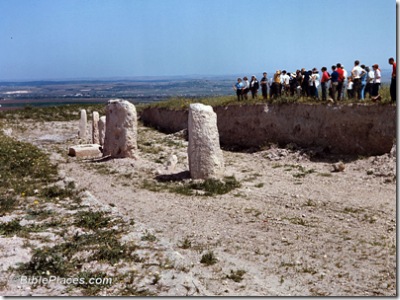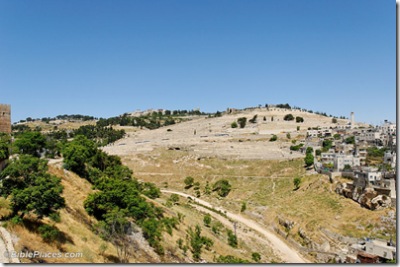The Star-Telegram has a brief article on the recent season of excavations at Gezer. The main finds mentioned are walls burned by the Assyrians in the 8th century and a rare silver coin from the Ptolemaic period. The excavation project is described at gezerproject.org, and some general information and pictures of Gezer is available at BiblePlaces.com.
The Israeli government is moving towards making the Mount of Olives a protected national park.
From Arutz-7:
The Knesset has taken the first step towards legislating the establishment of a new national authority that will preserve, rebuild and protect the ancient Mt. of Olives cemetery. The bill has passed its preliminary reading, and is being prepared for its additional readings….Without a national body coordinating efforts on the site’s behalf, “there is no one to preserve it, and no one to prevent illegal construction and vandalism there.”
Mt. of Olives overlooks the Old City of Jerusalem and the Temple Mount, and its summit is crowned by the Intercontinental Hotel. An estimated 20,000 gravesites remain in the ancient cemetery, out of some 70,000 – according to the lower estimates – that were there before the Jordanians took control of the site in 1948….
Of late, vandalism of Mt. of Olives gravestones has been discovered periodically. Just this past February, MKs of the Knesset’s State Control Committee toured the cemetery for the purpose of examining the many complaints of desecration, graffiti and smashed headstones. MK Zevulun Orlev (NRP) said at the time, “If such vandalism had occurred in a Jewish cemetery in Europe, it would shock the entire Jewish world; law enforcement authorities would attempt to capture the guilty parties… This is happening in the heart of the capital of Israel, adjacent to the Western Wall, [yet] the sovereign Jewish regime remains apathetic.”
Among the many famous Jewish historical figures buried on the Mt. of Olives are:
- Rabbi Moshe Ben-Nachman (Ramban)
- Rabbi Avraham Yitzchak Kook
- his son Rabbi Tzvi Yehuda Kook
- Israeli Chief Rabbi Shlomo Goren
- the Gerrer Rebbes
- Prime Minister Menachem Begin
- Nobel Prize laureate author S. Y. Agnon
- British Chief Rabbi Lord Immanuel Jakobovits
- Eliezer Ben-Yehuda, the father of modern Hebrew
- terrorist victim Eliyahu Asheri, kidnapped and murdered in 2006
- Aharon Hershler, murdered in 1873 when Arabs burst into his house.
Many Jews through the ages have sought burial there, because the site is mentioned in the Bible as the first spot from which the dead will be brought to life.
Concerning this last point, my understanding is that this view comes from Zechariah 14:3-4:
Then the Lord will go out and fight against those nations as when he fights on a day of battle. On that day his feet shall stand on the Mount of Olives that lies before Jerusalem on the east, and the Mount of Olives shall be split in two from east to west by a very wide valley, so that one half of the Mount shall move northward, and the other half southward.
I don’t have much to add to this story, but I think that some readers will find it of interest. “Bnei Menashe” means “sons of Manasseh,” a reference to one of the twelve tribes of Israel.
Seventy-eight members of India’s Bnei Menashe community entered Israel by bus from Jordan on Thursday and 40 more were scheduled to arrive at Ben-Gurion Airport early Friday morning on an El Al flight from Mumbai (Bombay)…. Freund said that the “Aliyah” (Jewish immigration to Israel) operation had been coordinated with all relevant government authorities. The Bnei Menashe entered Israel on tourist visas and will undergo conversion to Judaism in Israel. Then they will receive permanent status as citizens…. The Bnei Menashe claim descent from the tribe of Menashe, one of the ten tribes exiled from the Land of Israel by the Assyrian empire over 2,700 years ago. They reside primarily in the two Indian states of Mizoram and Manipur, along the border with Burma and Bangladesh. In recent years alone, over 800 members of the community have made Aliyah, thanks largely to the efforts of Shavei Israel, a Jerusalem-based group that reaches out and assists “lost Jews” seeking to return to the Jewish people. They reside mainly in Kiryat Arba, south of Jerusalem, and Beit El and Ofrah, north of Jerusalem…. The existence of the Bnei Menashe, known in India as the Manmassi tribe, was publicized in the Jewish world about 30 years ago by Rabbi Eliyahu Avichayil. When it was observed that the tribe’s members maintained certain ancient traditions unlike any observed in the Indian subcontinent, investigation revealed that the rituals were of Jewish origin…. Chief Sephardic Rabbi Shlomo Amar sent a delegation of two rabbinic judges to India about three years ago, to conduct a thorough investigation of the community and its origins. After a review of their findings, it was decided that the Bnei Menashe are in fact descendants of Israel and should be drawn closer to the Jewish people.
The full story is here.
Today’s Haaretz has an interesting article on the flooding of the coastal plain of Israel in the Early Bronze Age. The dating in the article is a little bit confusing, as it never gives an absolute date, just 5,500 years ago, and 3500 B.C. is usually assigned to the Chalcolithic period (cf. Mazar’s dating: 4300-3300 B.C.).
The concentration of population, commerce and trade in Israel’s coastal plain is not a phenomenon unique to our era. Even before the events the Bible describes in the Land of Israel, during the early first Bronze Age, 5,500 years ago, numerous communities dotted the coastal strip, from the vicinity of Gaza to the Galilee. The first royal dynasties appeared around that time in Egypt, and clay vessels uncovered in southern coastal communities indicate that the area (apparently under Egyptian control) served as an important trade route for the Egyptians.
And then, 5,500 years ago, say the archaeologists, there was a dramatic change. The coastal region was almost completely abandoned while concurrently in other areas an urban revolution was underway, with large fortified cities being built. After the era of urban, commercial prosperity, for almost a thousand years, the coastal plain mostly contained but a few small and scattered communities.
“The phenomenon is amazing,” says archaeologist Dr. Avraham Faust, director of Bar-Ilan University’s Institute of Archaeology. “There was a fairly large population in the coastal plain, and at the end of a relatively short process it emptied almost completely. In the alluvial areas, nearly all of the communities disappeared. The Egyptians also abandoned the coastal plain and trade no longer passed that way.”
Faust adds: “The key question that engaged us is why? What caused the community to disappear?” His research with Dr. Yosef Ashkenazy, a climate researcher at Ben-Gurion University of the Negev, suggests a comprehensive explanation of the phenomenon: The Canaanite coastal settlements were abandoned in the face of environmental change. Increased precipitation led to the flooding of parts of the coastal plain and to a rise in the level of groundwater, which eventually resulted in the spread of swamps, and that apparently caused the residents to leave the area.
You can read the rest here. The Hebrew version has a couple of photos.
HT: Joseph I. Lauer
- Tagged Discoveries
Archaeologists working at Hippos (Susita) on the eastern side of the Sea of Galilee have uncovered the footprint of the sandal of a Roman soldier. From the story in Haaretz:
The discovery of the print made by a hobnailed sandal, the kind used by the Roman legions during the time when Rome ruled the region, led to the presumption that legionnaires or former legionnaires participated in the construction of walls such as the one in which the footprint was found…. Prior to this finding, the sandal prints of Roman legionnaires had been discovered only in Hadrian’s Wall in Britain.
The story is brief and worth reading for more details, but one note for those who know the Bible better than the geography of the Bible: the reason that Hippos (Susita) is not mentioned in the New Testament is that it was one of the cities of the (largely Gentile) Decapolis, and Jesus’ ministry was to the Jewish people. There were a couple of occasions when Jesus visited the Decapolis, but it appears that these were not for the purpose of ministry. One example is the story of Jesus casting the demons into the swine (Mark 5:1-20). This event occurred as Jesus was trying to get away from the crowds, not do more ministry. The presence of pigs makes sense as well given that this was in an area controlled by Gentiles. Unfortunately many scholars have really flubbed the location of this miracle. If it was where they say (at Gergesa), then Hippos would have been mentioned by some of the gospel writers, instead of Gadara and Gerasa. But that is a subject for another day. All can agree that this discovery at Hippos is fascinating and instructive.
- Tagged Discoveries
This year’s excavations at Bethsaida (et-Tell) are mentioned in a brief news report in today’s Caspari Center Media Review.
This season’s excavations have come to an end at Bethesda, with new findings related to the Iron Age gate of the city as well as the plaza in front of it. According to Dr. Rami Arav, the excavation’s director, “In the area next to the gate, we found parts of the main street that led into the city from the gate. On this paved road, from the ninth century B.C.E., we plan to lead visitors to the site from the gate.”
I haven’t seen any other reports, but you can read week-by-week summaries of excavation at the www.bethsaidaexcavation.com website. Go here for the 2007 reports.
Search
About the BiblePlaces Blog
The BiblePlaces Blog provides updates and analysis of the latest in biblical archaeology, history, and geography. Unless otherwise noted, the posts are written by Todd Bolen, PhD, Professor of Biblical Studies at The Master’s University.
Subscribe
Tags
10th Century
American Colony Photos
Analysis
Antiquities Trade
Dead Sea
Dead Sea Scrolls
Discoveries
Egypt
Excavations
Forgery
Galilee
Greece
Holidays
Israel's Coast
Italy
Jerusalem
Jezreel Valley
Jordan
Jordan Rift
Judah
Lebanon
Lectures
Mediterranean Islands
Mesopotamia
Museums
Negev
New Exhibits
Persia
Philistines
Photo Resources
Picture of the Week
Pseudo-Archaeology
Resources
Sad News
Samaria
Shephelah
Syria
Technology
Temple Mount
Tomb of Jesus
Tourism
Travels
Turkey
Weather
Weekend Roundup
Links
Notice
As an Amazon Associate we earn from qualifying purchases. In any case, we will provide honest advice.

